African vultures come in many shapes and sizes, but there’s one thing they have in common: a craving for carrion.
These scavengers scour the savanna for a meal, scanning below with their excellent eyesight. It’s not unusual to see several vulture species on a kill, cleaning up other carnivores’ leftovers.
There are 11 vulture species in Africa, from Algeria down to the southern coast. Of those, nine are resident, or regularly migrate to the continent, while at least five species are endemic to Africa.
Once a common sight, African vultures have suffered considerable losses in recent years. Nowadays, several species are endangered.
Vultures don’t capture people’s imagination like many of Africa’s iconic creatures, and it’s not hard to see why. They’re not the most attractive birds, and have a close connection with death.
Perhaps they should be celebrated more, though. After all, vultures play an integral role in the ecosystem, functioning like nature’s garbage disposal teams. Without these bald birds cleaning up carrion, disease would spread, affecting all other animals – including humans.
Read on to learn all about these 11 African vultures, starting with the four critically endangered species.
White-Backed Vulture
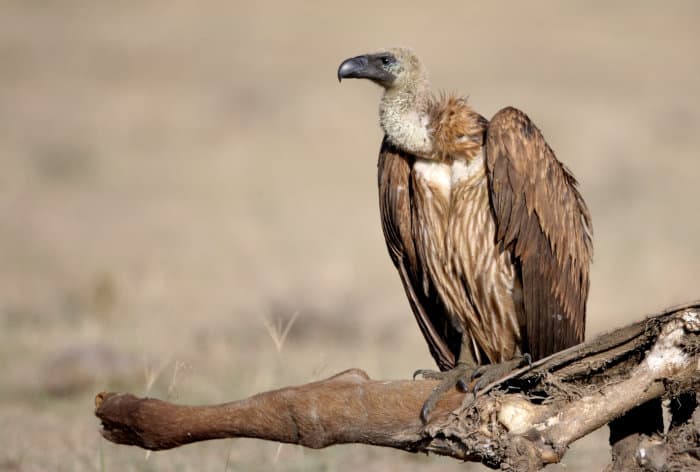
The white-backed vulture is Africa’s most common and widespread vulture species. This is one of just five vultures endemic to Africa (only occuring on the African continent). However, it’s classified as critically endangered, due to a rapid population decline in recent decades.
White-backed vultures have long necks covered in downy feathers and a darker, bald head. These social birds circle over carrion before feeding in large groups.
They’re found in a range of habitats but are most widespread in wooded savannas with trees for nesting.
White-backed vulture facts & features
- Medium-sized vulture with a weight of 4-7 kg and a wingspan of 1.96-2.25 m.
- Mostly dark plumage with a white “ruff” around the neck and a white patch on the back.
- Widespread habitat range, from Senegal in the east to Somalia in the west, and down through East Africa to Namibia and South Africa.
- Feed on soft tissue from large herbivores and livestock – their beaks can’t tear through tough skin.
- “Critically Endangered” due to habitat loss, hunting, and poisoning.
Rüppell’s Vulture
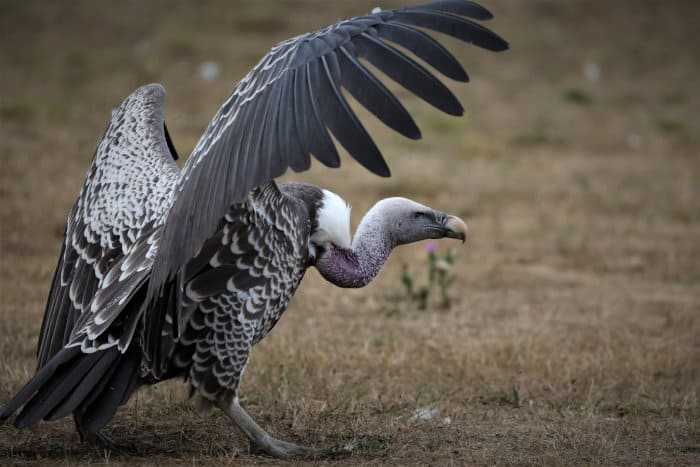
Rüppell’s vulture is another critically endangered African vulture species; there are barely 20 000 individuals left in the wild.
This species flies higher than any other – it’s been known to reach 11 278 metres (37 100 feet) above sea level.
When they come a bit closer to the ground, you can see Rüppell’s vultures in the Sahel region of North Africa, and East Africa. In recent years, some migrating birds have made it to the Mediterranean region.
Rüppell’s vulture facts & features
- Large vulture species, weighing 6.4-9 kg with a wingspan of 2.26-2.6 m.
- Bald head, mottled plumage, and a white collar around the neck.
- Forms breeding colonies, nesting on cliff faces.
- Lives in grasslands, mountains and woodlands in Sahel region and East Africa.
- Direct poisoning (for bushmeat or traditional medicine) and indirect poisoning (consuming drugs & pesticides) have caused dramatic population decline, and “Critically Endangered” status.
Hooded Vulture
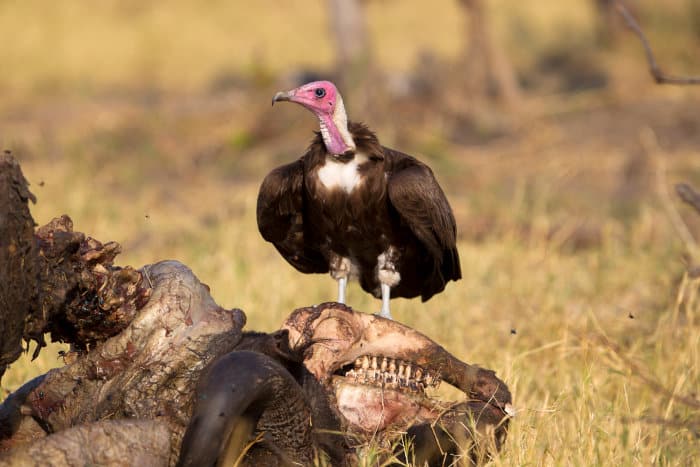
The hooded vulture is the second smallest of the African vultures and gets its name from the patch of downy feathers running down the back of its neck.
This species often lives near human settlements, scavenging like its larger relatives or eating a range of insects like grasshoppers and grubs.
Hooded vultures are endemic to Africa. However, hunting and poisoning have had a huge impact on this once-common vulture.
Hooded vulture facts & features
- One of the smallest vultures, weighing 1.5-2.6 kg with a 1.55-1.80 m wingspan.
- Pinkish-white face that flushes red when agitated, and scruffy brown plumage.
- Usually nest in trees beside water. Can be found in open grassland, wooded savannas, forest edges and coasts.
- Widespread distribution in sub-Saharan Africa but declining in most areas. The Gambia is one of their last remaining strongholds.
- Recently reclassified as “Critically Endangered” with population under 132 000 and rapidly decreasing.
White-Headed Vulture

No prizes for guessing how the white-headed vulture got its name. This medium-sized vulture has a distinctive pale white face and a pink beak. Contrasting black and white plumage makes this species unmistakeable.
Like hooded vultures, white-headed vultures are both endemic to Africa and critically endangered. Unlike hooded vultures, white-headed vultures are much shyer and largely avoid human habitation.
White-headed vulture facts & features
- Males weigh 4 kg on average and females 4.7 kg. Wingspan of 207-230 cm.
- Black, dark brown, and white plumage with white, downy feathers covering part of the head.
- Usual habitat is mixed, dry woodland at low elevations.
- Widespread in central, eastern and southern Africa but uncommon in most of its range. Endemic to the continent.
- “Critically Endangered”, with under 10 000 individuals left in the wild.
Cape Vulture
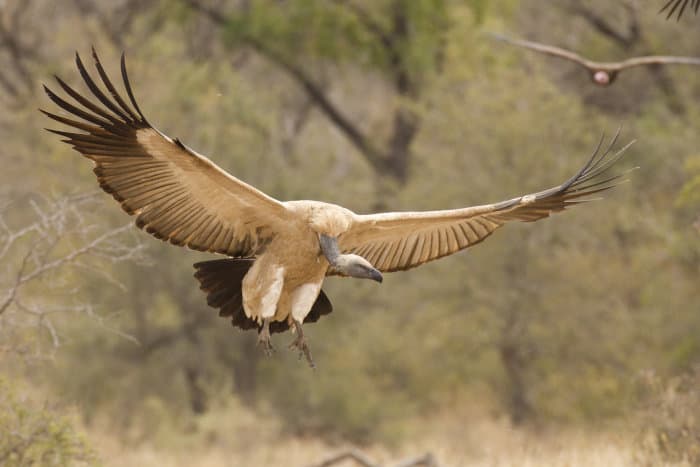
Cape vultures, or Cape griffon vultures, are another species on this list that only occurs in Africa. They’re endemic to southern Africa, mostly living in South Africa and Botswana.
The Cape vulture is one of the largest African vultures and mostly scavenges the carcasses of large mammals.
Cape vulture facts & features
- Large African vulture species, weighing up to 9 kg with a wingspan of 2.26-2.60 m.
- Creamy-buff plumage with a long, naked neck and bald head.
- Endemic to Africa, living in South Africa, Botswana, Lesotho, and parts of Namibia.
- Nests and roosts communally on cliff faces.
- Was classified as “endangered”, but recently downlisted to “Vulnerable”. Between 9600-12 800 mature individuals in the wild.
Lappet-Faced Vulture

The lappet-faced vulture, or Nubian vulture, is Africa’s largest vulture species. With their size and huge, powerful beaks, lappet-faced vultures are dominant at carcasses and boss around other African vultures.
This bald bird has a pink or red head with mostly black and brown plumage. Lappet-faced vultures dwell in dry savannas, deserts, mountainous regions, and arid plains.
Lappet-faced vulture facts & features
- Africa’s largest vulture, with some individuals weighing over 9 kg, and a wingspan of 2.5-2.9 m.
- Their powerful beaks tear through the toughest hides, opening them up for other vultures.
- Mostly a scavenger but will sometimes hunt small animals.
- Scarcely distributed in western, central, and eastern parts of Africa, down to southern Africa. There is also an Asian subspecies in the Arabian Peninsula.
- Classified as “Endangered” with a declining population of just 6500.
Egyptian Vulture

The Egyptian vulture, or “Pharoah’s chicken”, is a small Old World vulture and the only species in its genus Neophron. It is found in northern Africa as well as southern Europe and Asia.
Egyptian vultures are unmistakeable, with white plumage and bright yellow faces. This is one of the smartest African vultures and has been observed using pebbles to break open eggs.
Egyptian vulture facts & features
- Small vulture, weighing around 2 kg with a wingspan of 1.55-1.70 m.
- Eats carrion, insects, and even feces.
- Nests on rocky cliffs but increasingly drawn to human habitation including landfills.
- Three subspecies, with the most common subspecies found in northern Africa, southern Europe, the Middle East, Central Asia, and India.
- Classified as “Endangered”, with population estimates ranging from 12 400-36 000.
Bearded Vulture
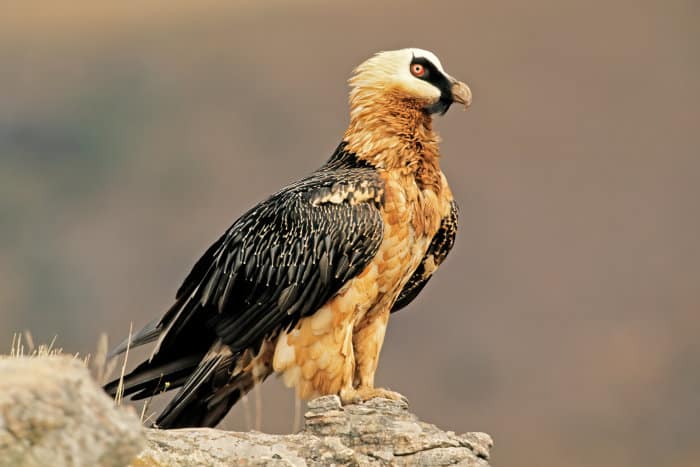
The bone-crunching bearded vulture, or lammergeier, has a diet of between 70-90% bone, which it digests with its strong stomach acids.
Bearded vultures live and breed in remote, mountainous regions of Africa, Asia, and Europe. Unlike most of its bald brethren, the lammergeier has a full head of hair.
Bearded vulture facts & features
- Large vulture, weighing around 5-8 kg with a 2.31-2.83 m wingspan.
- Dark grey wings and tail, with creamy plumage that often turns rust-coloured.
- Drops bones from a great height to get at the marrow within.
- Scattered populations in northern, eastern, and southern Africa. Also found in mountainous regions of Europe, the Caucasus, Tibet, and the Indian subcontinent.
- Classified as “Near Threatened” since 2014.
Palm-Nut Vulture
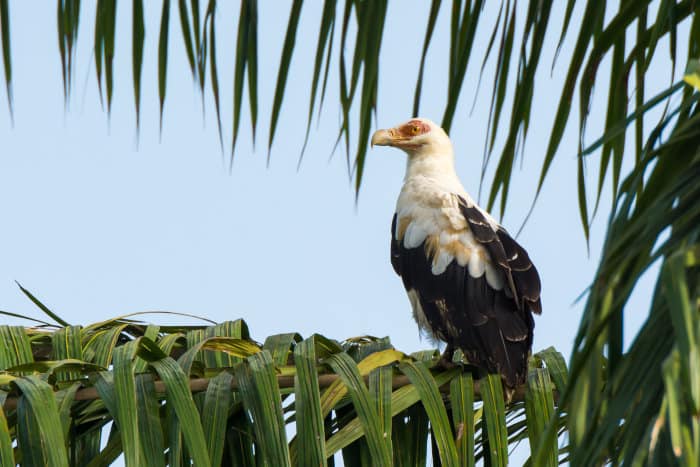
The palm-nut vulture, or vulturine fish eagle, is the only one of the African vultures classified as “least concern” by the IUCN. This endemic species is fairly common in much of Central Africa and some areas on the east and west coast.
Strangely, the palm-nut vulture is mainly vegetarian and only rarely feeds on carrion. As the name suggests, it mostly eats palm fruit.
Palm-nut vulture facts & features
- The smallest African vulture, weighing 1.3-1.7 kg with a 1.5 m wingspan.
- Distinctive white plumage with partially black wings and tail.
- Feeds on the fruit from oil palm and raffia palm trees, but will also eat fish, shellfish, small mammals, reptiles, and insects.
- Habitat is mainly forest and savanna near water. Can be seen near human habitation, especially where palm trees are planted.
- Status of “Least Concern”, with a stable population.
Rare Visitor: Eurasian Griffon Vulture
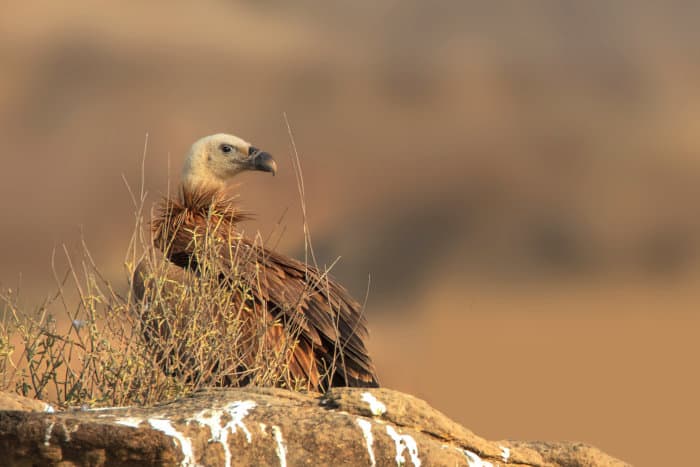
Rounding out the list of African vultures are two species that only occasionally visit the continent. The first is the Eurasian griffon vulture.
Eurasian griffon vultures mostly live in Europe and Asia. Some juvenile birds winter in North Africa, with one individual migrating from the Balkans to South Sudan.
Eurasian griffon vulture facts & features
- Large vulture, weighing around 6-10.5 kg with a wingspan of 2.3-2.8 m.
- White head and neck, pale brown body, and dark flight feathers.
- Closely related to the white-backed vulture.
Rare Visitor: Cinereous Vulture
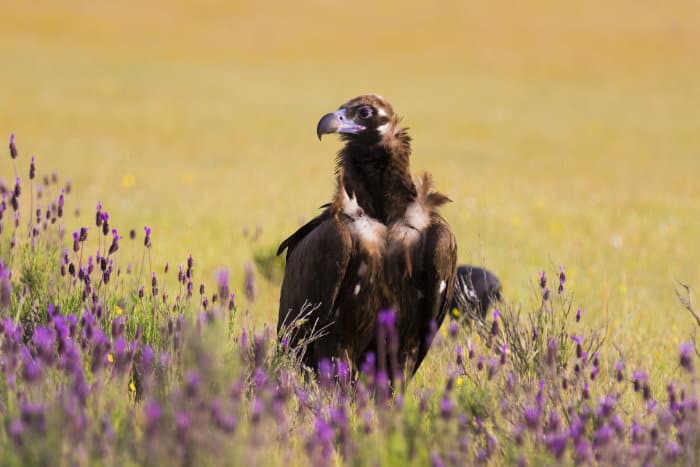
The huge cinereous vulture is the largest of the Old World vultures.
They’re mostly found in Spain and Portugal, the Middle East, and East Asia. Small numbers winter in Morocco.
Cinereous vulture facts & features
- Huge vulture, weighing 6.3-14 kg with a wingspan of 2.5-3.1 m.
- Dark brown to black plumage, with a black beak and lightly-feathered head.
- Small numbers migrate to Morocco for the winter, with one juvenile reaching the Niger-Nigeria border.
See African Vultures in the Wild
Most people don’t travel specifically to see African vultures – they might even be eating your favourite animal! Still, seeing these important birds is a privilege that’s becoming ever rarer.
Depending which parts of the continent you visit, you could see several African vulture species congregating around a kill, perched in a tree, or wheeling overhead.
Knowing the essential role they play in the ecosystem, you might just have a newfound appreciation for these amazing animals if you spot them on safari.
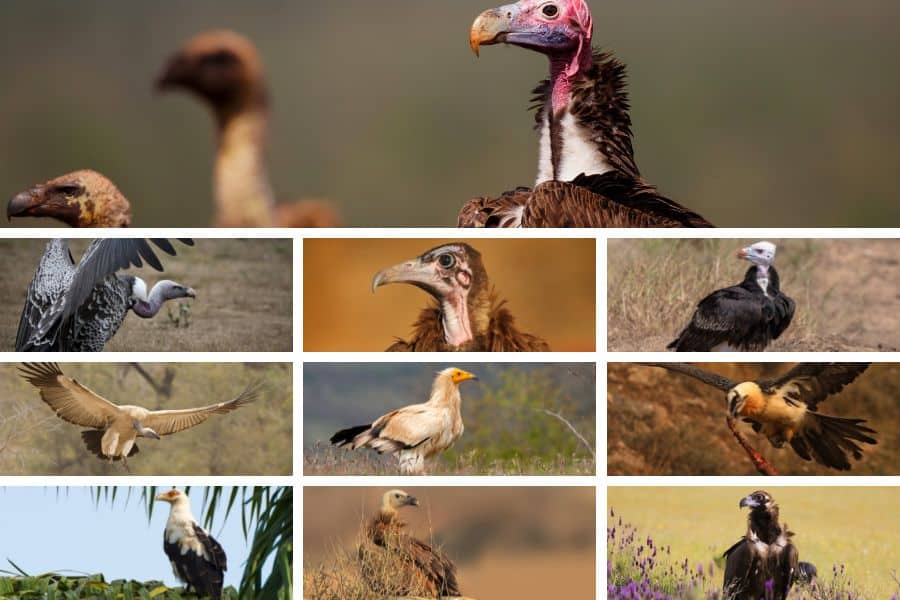
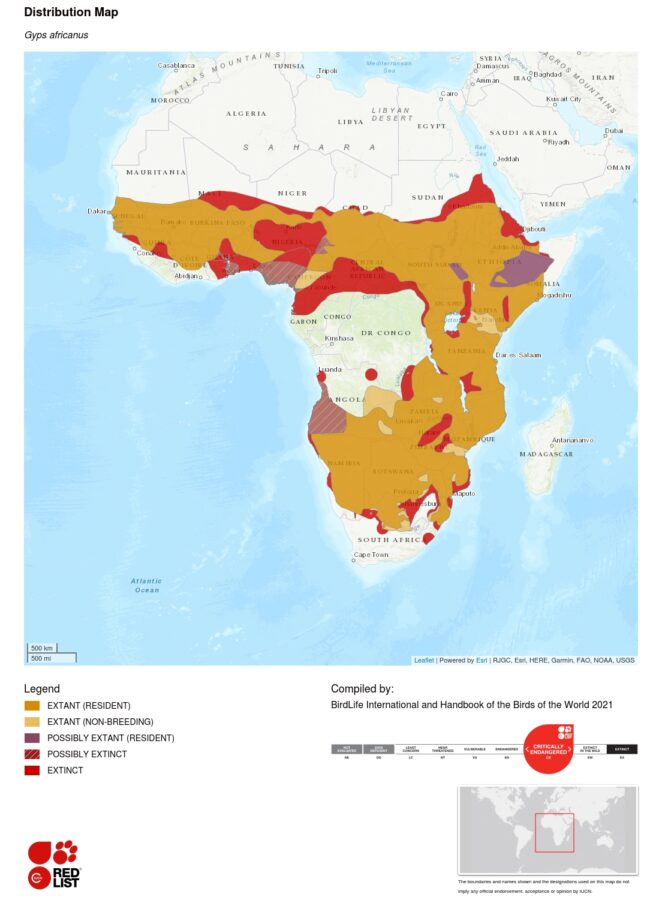

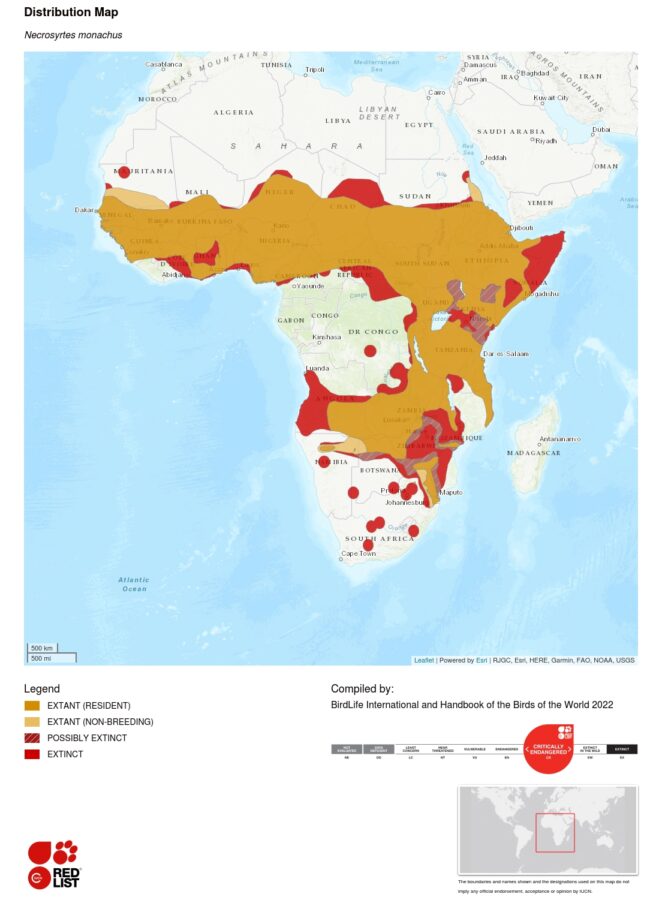
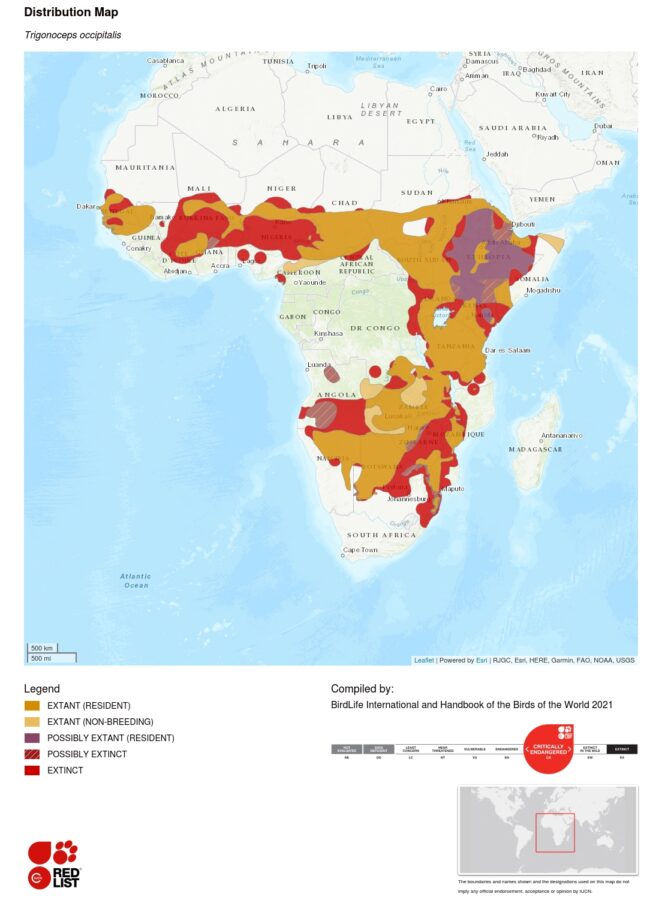



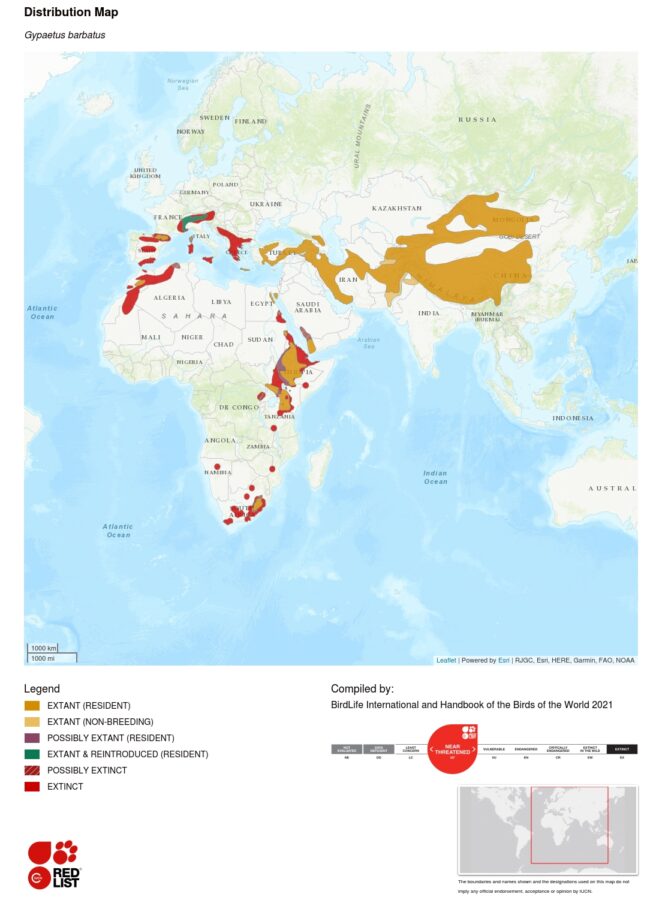

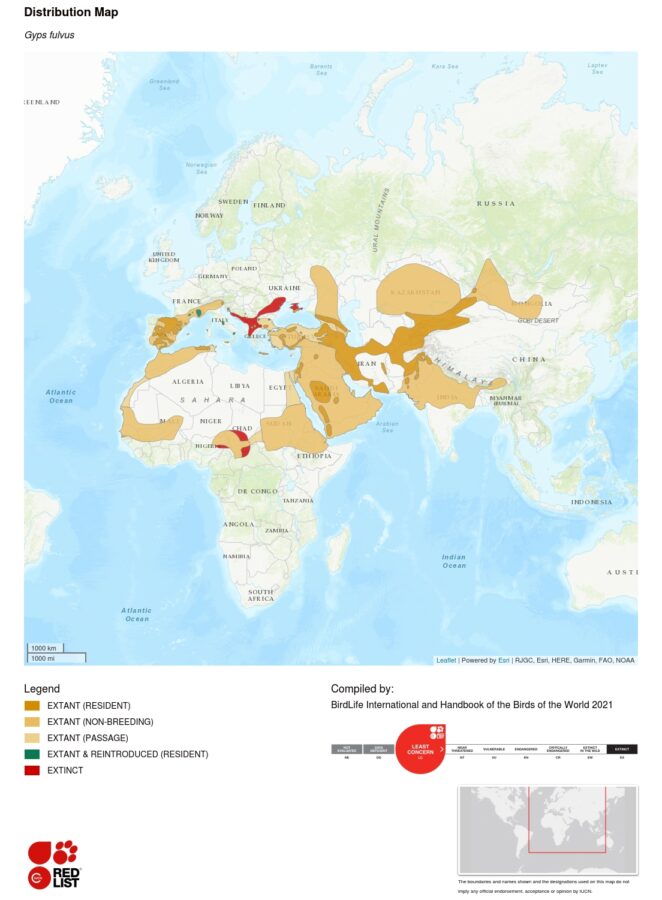
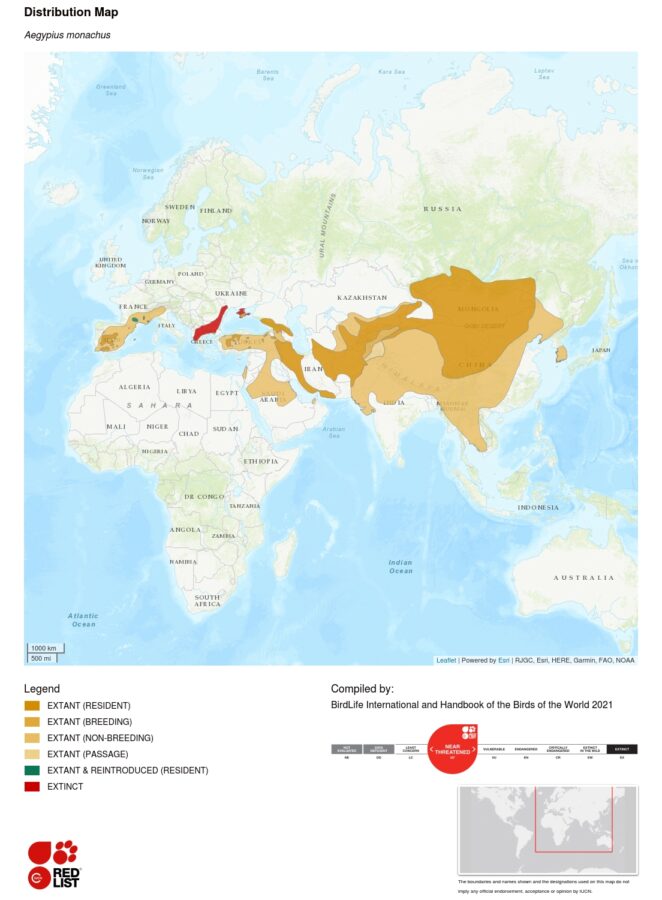
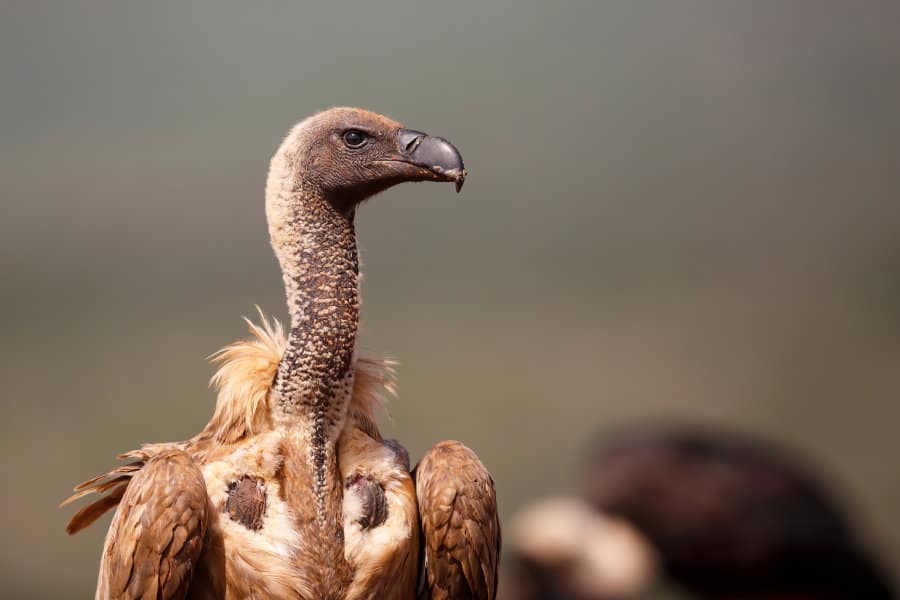
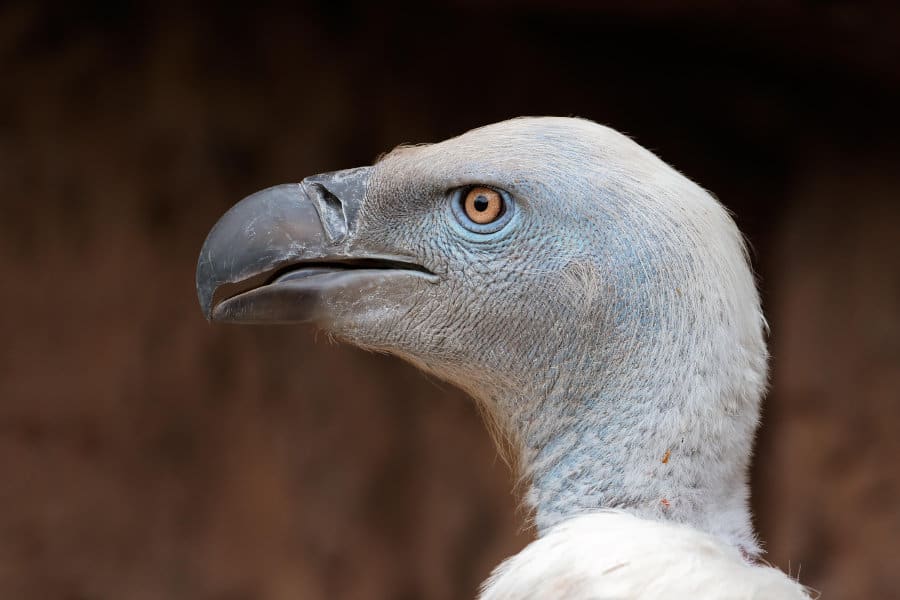

Hi,
Thanks for this nice article about vultures! They are intriging with there looks! As a painter I once painted the head of a King Vulture, so colourfull! I have a question. Reading a book the writer refers to a (impresive) luipaard-gier (a dutch word) in Botswana area. Google or Wiki doesn’t know this vulture. Searching Google for “leopard vulture” also is no hit. Do you have an idea which vulture this might be, assuming the writer is correct for a vulture species?
Hi Frans,
Great question, though unfortunately I do not have an answer for you. I’ve never heard of it, and as far as I know there’s only 11 African vulture species (as listed in this post).
But perhaps someone from our community can enlighten us?
Clearly, If I hear anything new on the topic I’ll definitely keep you posted.
Cheers,
Michael